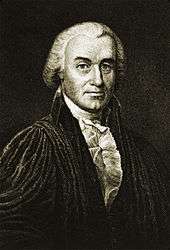Ellsworth Court
| Ellsworth Court | |
|---|---|
|
| |
| Established | 1796 |
| Dissolved | 1800 |
| Country | United States |
| Location |
Old City Hall Philadelphia, PA |
| Number of positions | 6 |
The Ellsworth Court refers to the Supreme Court of the United States from 1796 to 1800, when Oliver Ellsworth served as the third Chief Justice of the United States. Ellsworth took office after the Senate refused to confirm the nomination of Chief Justice John Rutledge, who briefly served as a Chief Justice as a recess appointment. Ellsworth served as Chief Justice until his resignation, at which point John Marshall took office. With some exceptions, the Ellsworth Court was the last Supreme Court to use seriatim opinions.[1]
Membership
The Ellsworth Court began in 1796 when the Senate confirmed President George Washington's appoint of Ellsworth. Washington had previously nominated both Rutledge and Associate Justice William Cushing to the seat, but Rutledge's nomination was denied by the Senate and Cushing refused the nomination on the basis of his health.[2] The Ellsworth Court began with Ellsworth and four Associate Justices from the Jay Court: William Cushing, James Wilson, James Iredell, and William Paterson. Associate Justice Samuel Chase took office shortly after Ellsworth's tenure began, filling the vacancy caused by the resignation of John Blair, Jr. during the Rutledge Court. Wilson died in 1798, and President John Adams appointed Bushrod Washington to take his seat. Alfred Moore joined the court in 1800 after the death of Iredell.

Chief Justice Associate Justice
Rulings of the Court
The Ellsworth Court issued some notable rulings:
- Hollingsworth v. Virginia (1798): In a per curiam opinion, the court ruled that the president plays no part in amending the Constitution.
- Calder v. Bull (1798): In an opinion written by Justice Chase, the court held that the Constitutional prohibition on ex post facto laws laws applies only to criminal acts, and that the Supreme Court of United States has no authority to determine whether state laws violate state constitutions.

